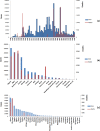An overview of bacterial meningitis epidemics in Africa from 1928 to 2018 with a focus on epidemics "outside-the-belt"
- PMID: 34592937
- PMCID: PMC8485505
- DOI: 10.1186/s12879-021-06724-1
An overview of bacterial meningitis epidemics in Africa from 1928 to 2018 with a focus on epidemics "outside-the-belt"
Abstract
Background: Bacterial meningitis occurs worldwide but Africa remains the most affected continent, especially in the "Meningitis belt" that extends from Senegal to Ethiopia. Three main bacteria are responsible for causing bacterial meningitis, i.e., N. meningitidis (Nm), S. pneumoniae and H. influenzae type b. Among Nm, serogroup A used to be responsible for up to 80 to 85% of meningococcal meningitis cases in Africa. Since 2000, other Nm serogroups including W, X and C have also been responsible for causing epidemics. This overview aims to describe the main patterns of meningitis disease cases and pathogens from 1928 to 2018 in Africa with a special focus on disease conditions "out-of-the-belt" area that is still usually unexplored. Based on basic spatio-temporal methods, and a 90-years database of reported suspected meningitis cases and death from the World Health Organization, we used both geographic information system and spatio-temporal statistics to identify the major localizations of meningitis epidemics over this period in Africa.
Results: Bacterial meningitis extends today outside its historical limits of the meningitis belt. Since the introduction of MenAfrivac vaccine in 2010, there has been a dramatic decrease in NmA cases while other pathogen species and Nm variants including NmW, NmC and Streptococcus pneumoniae have become more prevalent reflecting a greater diversity of bacterial strains causing meningitis epidemics in Africa today.
Conclusion: Bacterial meningitis remains a major public health problem in Africa today. Formerly concentrated in the region of the meningitis belt with Sub-Saharan and Sudanian environmental conditions, the disease extends now outside these historical limits to reach more forested regions in the central parts of the continent. With global environmental changes and massive vaccination targeting a unique serogroup, an epidemiological transition of bacterial meningitis is ongoing, requiring both a better consideration of the etiological nature of the responsible agents and of their proximal and distal determinants.
Keywords: Epidemics; Epidemiology; In- and outside the meningitis belt; Meningitis; Pathogens; Spatial analysis; Time-series.
© 2021. The Author(s).
Conflict of interest statement
The authors declare that they have no competing interests.
Figures





References
-
- WHO | Managing epidemics [WWW Document], 2018. WHO. http://www.who.int/emergencies/diseases/managing-epidemics/en/ Accessed May 9 2019.
-
- WHO, 1998. WHO | Control of epidemic meningococcal disease. WHO practical guidelines. 2nd edition [WWW Document]. WHO. https://www.who.int/csr/resources/publications/meningitis/WHO_EMC_BAC_98... Accessed 13 Oct 2019.
-
- Bertherat E, Yada A, Djingarey MH, Koumare B. First major epidemic caused by Neisseria meningitidis serogroup W135 in Africa? Med Trop Rev Corps Sante Colon. 2002;62:301–304. - PubMed
Publication types
MeSH terms
Substances
LinkOut - more resources
Full Text Sources

